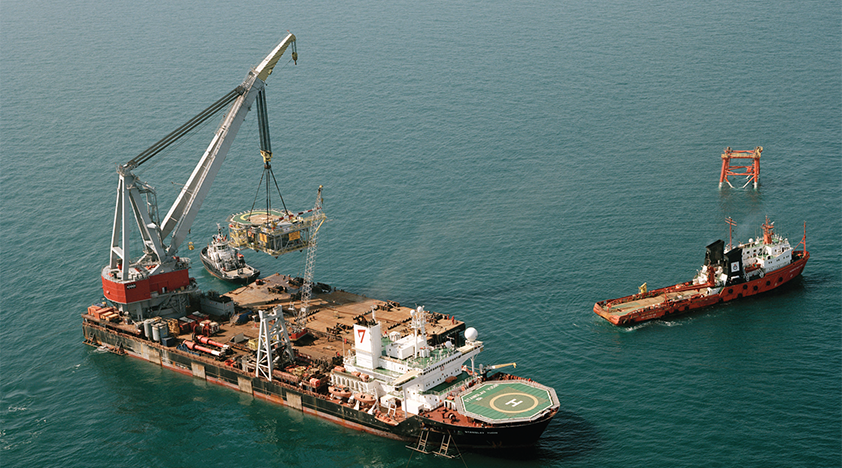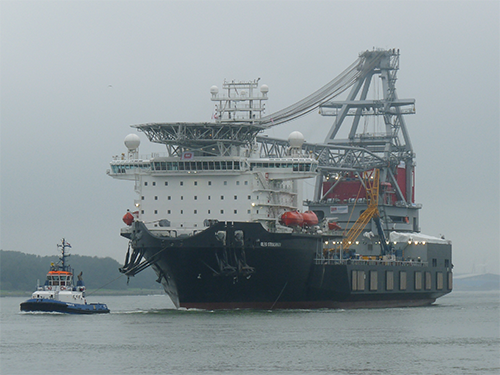
Seaway Heavy Lifting
Uplifting approach
Seaway Heavy Lifting (SHL) is an offshore installation contractor that specialises in the installation and decommissioning of offshore platforms.
To date, it has worked primarily in the North Sea, Mediterranean and Middle East regions and has plans for expansion to Asia in the future. It runs one anchoring tugboat as well as two main crane vessels – HLV Stanislav Yudin and HLV Oleg Strashnov. This second vessel was added to the company’s fleet at the beginning of 2011, and has up to 14 knots sailing speed and 5000 tonnes lifting capacity and represents a huge step forward in the company’s capabilities.
The company was founded in 1992 by a group of engineers with experience in the construction of offshore platforms dating back to the initial North Sea structures during the 1970s. With its shallow draft Stanislav Yudin, which then had a lifting capacity of 2000 tonnes, SHL executed its first project to install a number of subsea structures for Statoil as part of Stolt Comex Seaway’s contract with Statoil. In the same period, the company installed gas platform installations in both the UK and Dutch regions of the North Sea. By the late 1990s, projects involved increasingly larger lifts so the Stanislav Yudin was upgraded to its current capacity of 2500 tonnes. Seeing this trend for topsides to increase in size, SHL decided to acquire a bigger crane vessel rather than upgrading the Stanislav Yudin further, and it chose to invest in the building of a new ship – the Oleg Strashnov.
Marketing and business manager Aart Ligterink talks more about it: “In 2005 we saw the real need for a new, larger vessel so we began designing the Oleg Strashnov. It has a special patented dual width hull design, meaning it will have a better workability than a conventional monohull. Furthermore it has a sailing speed of 14 knots and a 5000 tonne lifting capacity so that we can respond quickly to the demands of our clients. Another advantage is that the A-frame can be lowered in a certain way to allow passage through the Suez Canal, thus allowing for fast passage to India and South East Asia.”
Oleg Strashnov is equipped with a DP3 system, the highest safety class of dynamic positioning system in which sensor information is fed to an automatic controller that also has multiple independent backup systems. SHL felt this was a necessary step for the ship because of its potential use in deep waters and in congested areas with many pipelines or cables on the seabed.
One such type of operation that will become more common is the installation of modules on floating storage production and offloading (FPSO) vessels. “A host of FPSOs entered service over the last decade,” Aart comments, “in the North Sea, West Africa and South East Asia. With a lot of them now over ten years old they are in the market for replacement modules or additional modules tying them to new wells. To disconnect and bring to shore these FPSOs, however, would mean a lot of money lost due to lack of production. With our DP3 crane vessel we can stay alongside the FPSO and install modules in the field, meaning hardly any lost production and a huge financial saving.”
 Although SHL has carried out projects across the world, to date its main focus has been the North Sea, the Mediterranean and the Middle East. During the northern hemisphere’s summer months, contracts are focused around the North Sea whilst during the winter months, due to rough seasonal conditions, the company moves its work towards the Mediterranean and Middle East. With the Oleg Strashnov becoming operational, SHL now also focuses heavily on South East Asia where a substantial demand for a DP3 crane vessel with a 5000 mt lift capacity is foreseen in the future. Over the years SHL’s customers have included numerous big name operators such as Gaz de France, Conoco and BP; one of the company’s biggest projects was for Conoco when it was contracted to deconstruct the Viking A Complex. This involved the total removal of 10,000 tonnes of material and though Conoco instructed the company to achieve a 99.8 per cent recycle rate, SHL achieved less than this – 99.7 per cent, which is still a record in the industry.
Although SHL has carried out projects across the world, to date its main focus has been the North Sea, the Mediterranean and the Middle East. During the northern hemisphere’s summer months, contracts are focused around the North Sea whilst during the winter months, due to rough seasonal conditions, the company moves its work towards the Mediterranean and Middle East. With the Oleg Strashnov becoming operational, SHL now also focuses heavily on South East Asia where a substantial demand for a DP3 crane vessel with a 5000 mt lift capacity is foreseen in the future. Over the years SHL’s customers have included numerous big name operators such as Gaz de France, Conoco and BP; one of the company’s biggest projects was for Conoco when it was contracted to deconstruct the Viking A Complex. This involved the total removal of 10,000 tonnes of material and though Conoco instructed the company to achieve a 99.8 per cent recycle rate, SHL achieved less than this – 99.7 per cent, which is still a record in the industry.
Aart explains why he thinks the company has been successful for almost 20 years: “SHL is a flexible business. We have high levels of expertise among our staff, both in office and offshore branches. Most importantly, though, we look for solutions in co-operation with our clients. Our aim is to solve the problem by working out a solution that is suitable for the client then delivering a safe, reliable service. Our aim is to be very client-orientated, have an open mind and good communication with the customer.”
Health and safety is an essential issue for a company like SHL, which operates in a difficult environment. Whilst it is accredited with ISO 9001 and OHSAS 18001 as evidence of its commitment, the most important part of its safety management strategy is the presence of safety officers on all vessels during all projects. For the duration of a project, safety officers will meet with the project engineer, superintendent and barge foreman every morning to discuss and minimise risks.
There are other challenges too, as Aart highlights: “To effectively allocate vessels to a project and come to the most optimal platform design, it is best if SHL becomes involved at an early stage of the project. Sometimes companies will call in very late – just a year before installation, let’s say – and this makes the job more difficult for everyone. If they are already considering a project then it is good for them to have a contractor like ourselves on board so that we can discuss the most efficient and economical ways for platforms to be installed.”
With the launch of Oleg Strashnov, prospects for SHL have expanded tremendously as it is able to travel globally and quickly and handle lifting projects with extreme requirements. The increase in platform decommissioning promises to deliver plenty of opportunities, whilst the growing market in offshore renewable energy offers the company new projects to pursue.
“The renewables sector is in its start-up phase and we, as an expert offshore installation contractor with a history of skills and knowledge, are in a position to offer utility companies our services,” Aart asserts. “The offshore wind sector is moving from coastal waters to further offshore, meaning other bigger structures and other environmental conditions, and SHL’s extensive experience and top quality dedicated heavy lift crane vessels will enable us to offer the utility companies a safe and reliable installation method. We can offer to install windmill foundation structures or substations for them. For example, we have already installed 140 monopiles at the Greater Gabbard Windfarm. These piles were huge – six metres diameter, 65 metres long and over 700 tonnes, and were installed in the summer and winter period. During December, the Stanislav Yudin installed 23 piles, whilst during the summer the vessel installed an impressive 29 piles in one month. We see a clear tendency of different utility companies wanting to talk with us about such projects in the future.”
How the future will look is difficult to tell with oil prices bouncing between $30 and $147/bbl and back to $55 again, and an offshore wind market that must be supported heavily by subsidies. Nevertheless, Aart explains that SHL will stay focussed on the energy market with the aim of providing its valued customers the continued heavy lift services in a safe and reliable manner.
“For us it is important to further grow,” he concludes. “Whether we invest in another vessel depends on the market situation, but it’s not something we will rule out. Looking into the future, we want to be recognised industry-wide as a reliable and efficient heavy lift service provider.”
Seaway Heavy Lifting
Services: Offshore heavy lifting